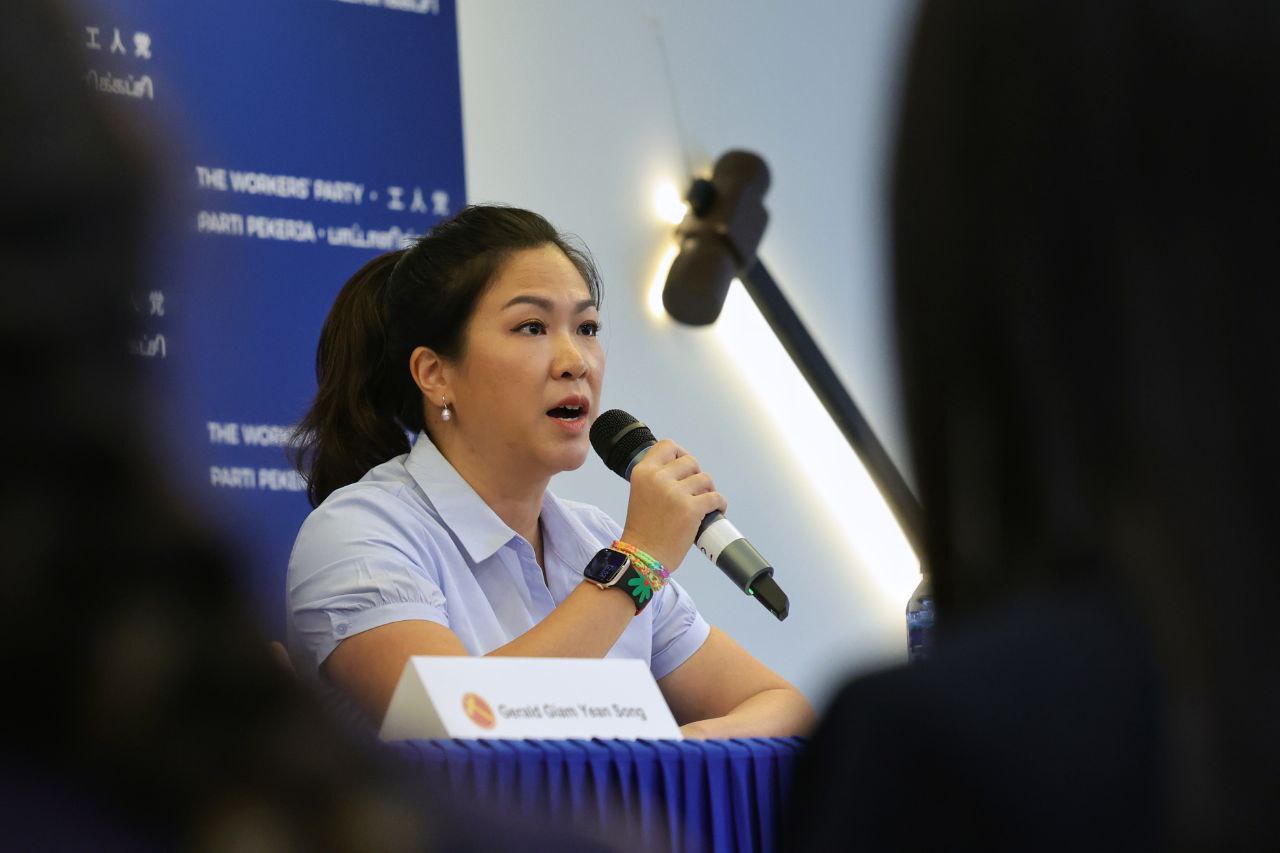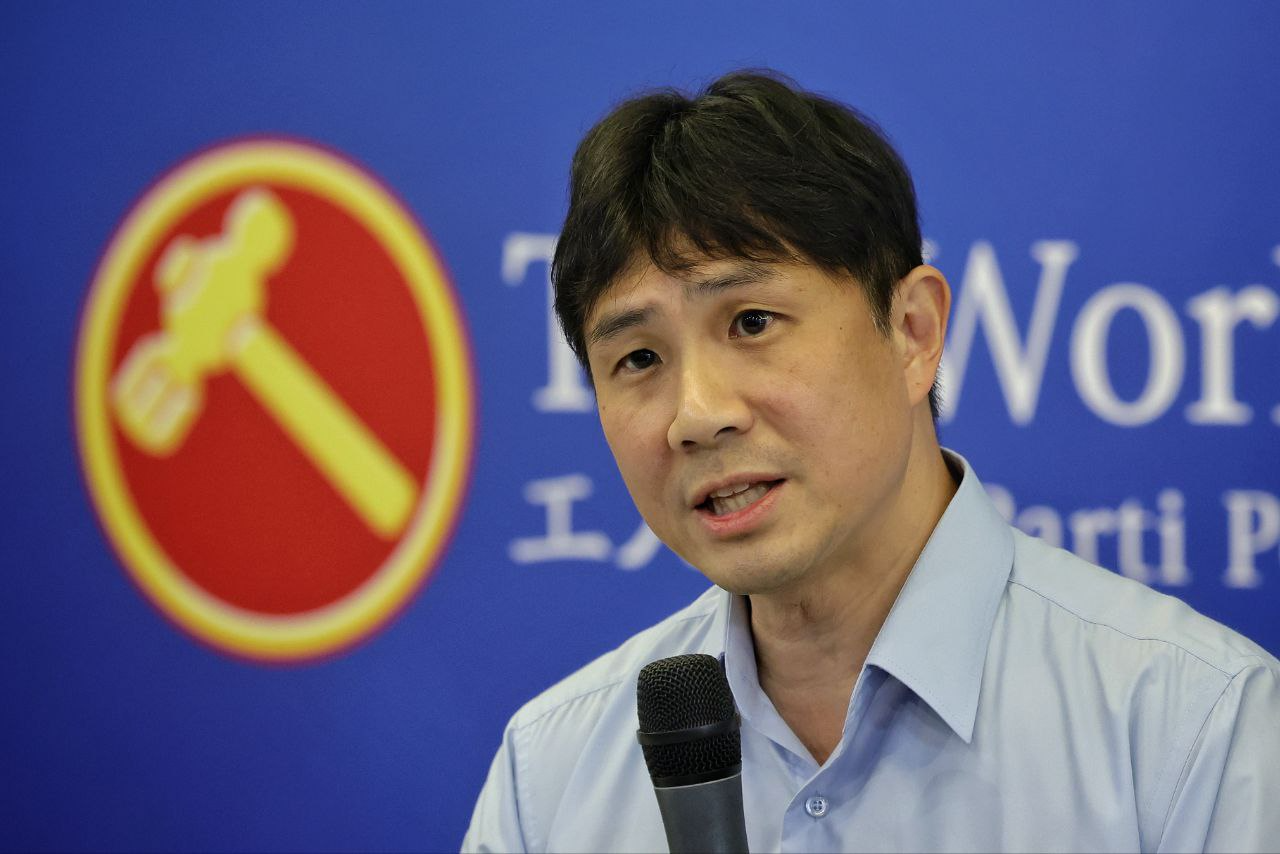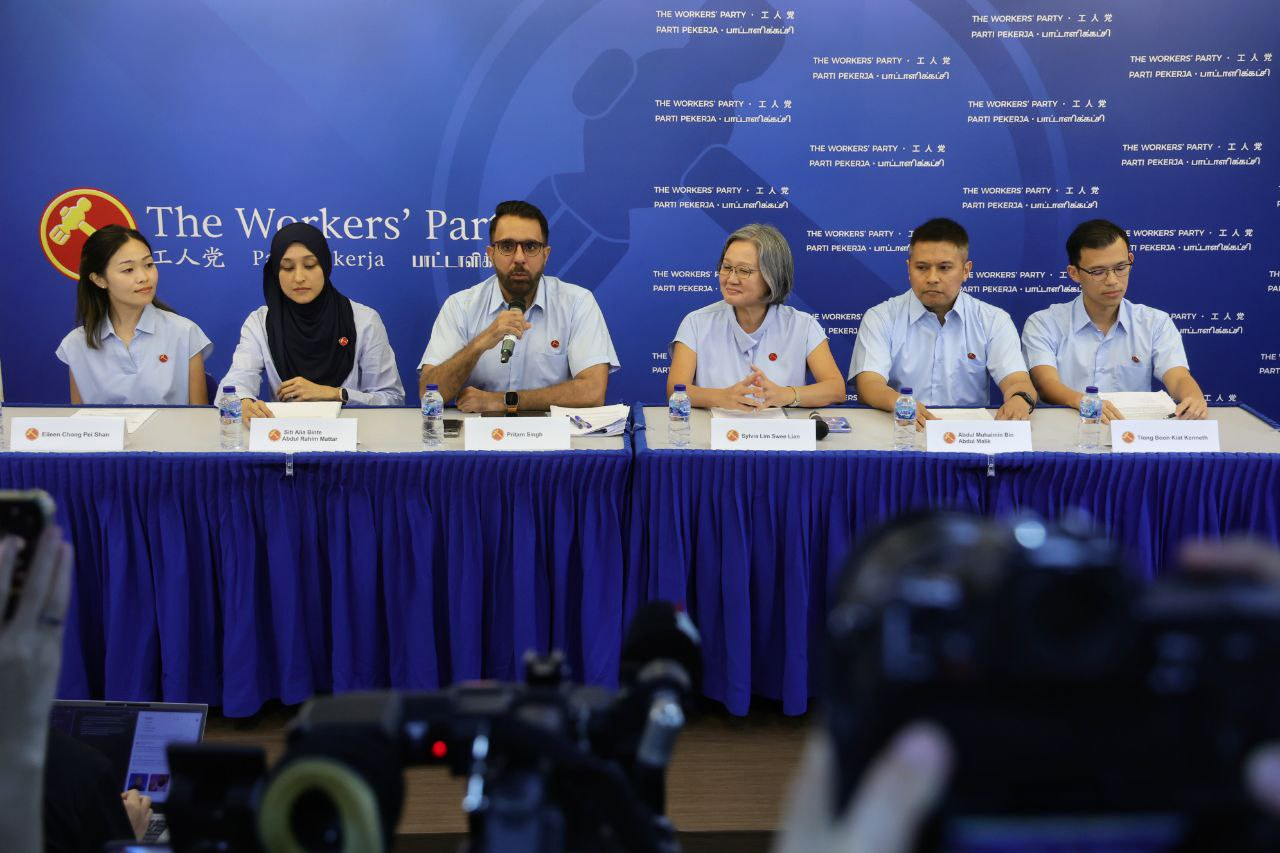You are using an out of date browser. It may not display this or other websites correctly.
You should upgrade or use an alternative browser.
You should upgrade or use an alternative browser.
[GE2025] The Workers' Party (WP) Discussion Thread
- Thread starter s-ghost
- Start date
More options
Who Replied?nachtsid.er
Arch-Supremacy Member
- Joined
- Jul 8, 2019
- Messages
- 23,758
- Reaction score
- 12,705
Nothing wrong , 2 state solution is also the official stand of sg govt
yperic
Greater Supremacy Member
- Joined
- Jan 14, 2003
- Messages
- 82,941
- Reaction score
- 30,714
WP manifesto unveiling: Policies to promote inclusion, equality have to take centre stage, says He Ting Ru

Incumbent Sengkang GRC MP He Ting Ru says at the press conference that policies to promote inclusion and equality have to take centre stage, especially in the context of global issues such as Covid-19 and wars, which have shown to exacerbate discrimination and inequality.
There is a need for a formalised way to track social outcomes and developments beyond gross domestic product as a measure of policy success, says Ms He.
Other policy suggestions that the WP outlined in the third section of its manifesto include extended childcare leave on a per-child basis, reduction of class sizes, and allowing singles to apply for Build-To-Order flats at age 28.
ST PHOTO: KEVIN LIM

Incumbent Sengkang GRC MP He Ting Ru says at the press conference that policies to promote inclusion and equality have to take centre stage, especially in the context of global issues such as Covid-19 and wars, which have shown to exacerbate discrimination and inequality.
There is a need for a formalised way to track social outcomes and developments beyond gross domestic product as a measure of policy success, says Ms He.
Other policy suggestions that the WP outlined in the third section of its manifesto include extended childcare leave on a per-child basis, reduction of class sizes, and allowing singles to apply for Build-To-Order flats at age 28.
ST PHOTO: KEVIN LIM
Why don't slyvia lim step down to spend more time with her hubby.WP leaders Pritam Singh, Sylvia Lim arrive at party HQ


WP chief Pritam Singh and chairwoman Sylvia Lim have arrived at the party headquarters in Geylang. New candidates Kenneth Tiong and Abdul Muhaimin Abdul Malik are also seen in the building.
The party is expected to unveil its manifesto and candidate line-up this afternoon for the upcoming general election.
ST PHOTOS: KEVIN LIM
ThisIsSparta
Supremacy Member
- Joined
- Jan 26, 2014
- Messages
- 5,662
- Reaction score
- 1,456
oh no.. they are going to lose votes from edmwers
oh wait.. edmwers not their targeted segment.
WP already moved pass having to depend on these kind of people
oh wait.. edmwers not their targeted segment.
WP already moved pass having to depend on these kind of people
yperic
Greater Supremacy Member
- Joined
- Jan 14, 2003
- Messages
- 82,941
- Reaction score
- 30,714
More support needed for workers facing job insecurity: Jamus Lim

Incumbent Sengkang GRC MP Jamus Lim says at the press conference that greater support for job insecurity is necessary in this uncertain economic environment and WP is proposing redundancy insurance for all local workers.
Under WP’s scheme, an involuntarily retrenched worker will receive 40 per cent of his or her last drawn salary, capped at 40 per cent of Singapore’s prevailing median income, for up to six months, according to its manifesto.
ST PHOTO: KEVIN LIM

Incumbent Sengkang GRC MP Jamus Lim says at the press conference that greater support for job insecurity is necessary in this uncertain economic environment and WP is proposing redundancy insurance for all local workers.
Under WP’s scheme, an involuntarily retrenched worker will receive 40 per cent of his or her last drawn salary, capped at 40 per cent of Singapore’s prevailing median income, for up to six months, according to its manifesto.
ST PHOTO: KEVIN LIM
yperic
Greater Supremacy Member
- Joined
- Jan 14, 2003
- Messages
- 82,941
- Reaction score
- 30,714
WP repeats calls to lower voting age to 18
The Workers’ Party is repeating its call to lower the voting age to 18, says Ms He, adding that this will allow younger Singaporeans to meaningfully participate in civic life earlier.
Other proposals in the fourth section of WP’s manifesto also have to do with entrenching safeguards to protect public institutions, enhancing judicial oversight and improving policing, she says.
The Workers’ Party is repeating its call to lower the voting age to 18, says Ms He, adding that this will allow younger Singaporeans to meaningfully participate in civic life earlier.
Other proposals in the fourth section of WP’s manifesto also have to do with entrenching safeguards to protect public institutions, enhancing judicial oversight and improving policing, she says.
s-ghost
High Honorary Member
- Joined
- Jan 30, 2010
- Messages
- 153,495
- Reaction score
- 51,399
thank you for adopting ah gui's manifestowah this one is huge if developed. those chain coffee shops owner won't be happy
https://forums.hardwarezone.com.sg/threads/ah-guis-manifesto-for-hawker-centres.7048735/
yperic
Greater Supremacy Member
- Joined
- Jan 14, 2003
- Messages
- 82,941
- Reaction score
- 30,714
Higher allowances for full-time NSmen, stronger food security
As he moves on to the last section of the manifesto, incumbent Aljunied GRC MP Gerald Giam touches on issues relating to security and geopolitics in the manifesto.
He says that national defence is the core responsibility of any government and underpins our national resilience. He adds that WP supports maintaining and building up a strong military to protect Singapore’s sovereignty and security.
Among the suggestions that the party has put forward are stronger countermeasures against grey zone tactics and raising the median allowances for full-time national servicemen to a median wage of $1,600 per month to “better reflect the contributions and sacrifices that our young men make”.
Mr Giam also highlights the need for Singapore to strengthen its food security.
Among the proposals is an increase in local farm uptake of locally produced food by major institutional buyers, which will promote the market viability of local farmers and enhance national food security.
As he moves on to the last section of the manifesto, incumbent Aljunied GRC MP Gerald Giam touches on issues relating to security and geopolitics in the manifesto.
He says that national defence is the core responsibility of any government and underpins our national resilience. He adds that WP supports maintaining and building up a strong military to protect Singapore’s sovereignty and security.
Among the suggestions that the party has put forward are stronger countermeasures against grey zone tactics and raising the median allowances for full-time national servicemen to a median wage of $1,600 per month to “better reflect the contributions and sacrifices that our young men make”.
Mr Giam also highlights the need for Singapore to strengthen its food security.
Among the proposals is an increase in local farm uptake of locally produced food by major institutional buyers, which will promote the market viability of local farmers and enhance national food security.
mgx-alander
Greater Supremacy Member
- Joined
- Jan 19, 2008
- Messages
- 95,437
- Reaction score
- 13,709
I agree that hdb should take over coffeeshops and not those siaolang who pay 40 mil for a coffeeshop then charge 10k rent per stall
That takeover caused my fav zhichar stall to uplorry
That takeover caused my fav zhichar stall to uplorry
yperic
Greater Supremacy Member
- Joined
- Jan 14, 2003
- Messages
- 82,941
- Reaction score
- 30,714
No risk that PAP will end up with weak government: Gerald Giam
While addressing questions from reporters, incumbent Aljunied MP Gerald Giam says there is no risk that the PAP will end up with a weak government.
“There’s too much power centralised in the PAP, and that will cause the rest of us, Singaporeans, to not be able to have that bargaining power with the government,” says Mr Giam.
He reiterates that WP wants to put forward good candidates to come up with alternative ideas that are not subject to the PAP whip.
While addressing questions from reporters, incumbent Aljunied MP Gerald Giam says there is no risk that the PAP will end up with a weak government.
“There’s too much power centralised in the PAP, and that will cause the rest of us, Singaporeans, to not be able to have that bargaining power with the government,” says Mr Giam.
He reiterates that WP wants to put forward good candidates to come up with alternative ideas that are not subject to the PAP whip.
Nuclear Boy
Arch-Supremacy Member
- Joined
- Dec 19, 2009
- Messages
- 16,814
- Reaction score
- 8,431
PAP is already of this stance.
Wah why this angle got lao chio cougar look.HTR looks different

yperic
Greater Supremacy Member
- Joined
- Jan 14, 2003
- Messages
- 82,941
- Reaction score
- 30,714
Gerald Giam on what distinguishes WP’s policy proposals from PAP’s
In putting forward its policy proposals, WP’s Mr Gerald Giam says that the party does not simply take reference from what the PAP has done and do something different.
“What we do is, first, we listen to our constituents on the ground. That’s the benefit of having elected MPs,” he says in response to a question on the WP being labelled as “PAP-lite” and what distinguishes its proposals from the PAP’s.
Elected MPs are able to get feedback from residents, he says, and from there, the party can make an assessment on whether the current policies have gaps that need to be highlighted.
“If the policies happen to align with the PAP’s, well, we make no apologies for that,” he says.
He adds that the WP has been leading policies in many ways, but it is not a contest about who is first and second.
“What is more important is that policies fit for Singapore are the policies benefiting our residents, benefiting Singaporeans as a whole,” he says.
In putting forward its policy proposals, WP’s Mr Gerald Giam says that the party does not simply take reference from what the PAP has done and do something different.
“What we do is, first, we listen to our constituents on the ground. That’s the benefit of having elected MPs,” he says in response to a question on the WP being labelled as “PAP-lite” and what distinguishes its proposals from the PAP’s.
Elected MPs are able to get feedback from residents, he says, and from there, the party can make an assessment on whether the current policies have gaps that need to be highlighted.
“If the policies happen to align with the PAP’s, well, we make no apologies for that,” he says.
He adds that the WP has been leading policies in many ways, but it is not a contest about who is first and second.
“What is more important is that policies fit for Singapore are the policies benefiting our residents, benefiting Singaporeans as a whole,” he says.
s3nt1n3l
High Supremacy Member
- Joined
- Feb 26, 2008
- Messages
- 39,272
- Reaction score
- 1,792
Strengthen Retirement Adequacy by Reforming the CPF
The CPF scheme plays an important role in securing Singaporeans' retirement needs. Any enhancement of these returns will benefit Singaporeans, particularly when inflation and interest rates are relatively high. There is a need to regularly review and refine CPF policies to ensure they function as effectively as possible in fulfilling their purpose.
Enable Co-Investing of CPF Savings with GIC
GIC Private Limited (GIC) has attained a 6.9 per cent return over the past 20 years. In contrast, CPF Special Account (SA) rates have remained at a floor rate of 4 per cent and Ordinary Account (OA) rates have been even lower. Excess returns above CPF interest rates, earned by GIC via investing CPF monies, through the issuance of special Singapore govt securities, should be shared with CPF account holders.
Higher returns are even more important when inflation is high. CPF interest rates have not made up for the rate of price increases, resulting in negative real returns. This has eroded our retirees’ purchasing power, who do not have inflation-adjusted wage adjustments, and this ultimately compromises their retirement adequacy.
CPF should give members the option to co-invest a portion of their CPF savings with GIC in a dynamic portfolio, to enjoy higher returns without incurring high management fees.
Introduce a Special Dividend from GIC Investments for CPF members
As GIC indirectly invests CPF funds, CPF members must be provided transparency on the nature and performance of their money. The government should notify CPF members of GIC’s annualised total and investor returns for not just the five, 10 and 20-year horizon, but also the one- and three-year horizon. This is consistent with the standard reporting practices of private sector asset managers, as well as other sovereign wealth funds with strong governance scores.
GIC should also report the 10-year moving average difference between the investment returns of GIC and the net interest payable on CPF member balances. A third of this difference, where positive, should be returned as a special dividend and paid into CPF members’ SAs.
Review the CPF OA Interest Rate Formula and Set a New Level
The CPF OA interest rate serves as an important benchmark rate for Singaporeans’ semi-liquid CPF savings. The current formula – which is tied to the three-month average rate of major local banks’ interest rates, subject to a 2.5 per cent minimum – has been in place since 1999 and has not kept up with significant changes to the global interest rate environment or local deposit offerings.
The formula for setting the CPF OA interest rate should be reviewed and set at a level that is more consistent with market realities. One possibility is to link OA rates instead to the Singapore Overnight Rate Average (SORA).
Permanently De-Link HDB Loan Rate from CPF OA Rate
Presently, the interest rate of HDB concessionary loans is set at 0.1 per cent above the CPF OA rate. This unnecessarily limits the freedom of CPF to increase OA rates, for fear of affecting those serving HDB loan mortgages.
The HDB concessionary loan rate should be de-linked from the CPF OA rate. It should instead be pegged at 0.1 per cent above the average three-month fixed deposit rate of the major local banks, with a floor of 2.6 per cent.
this one also worth considering
yperic
Greater Supremacy Member
- Joined
- Jan 14, 2003
- Messages
- 82,941
- Reaction score
- 30,714
WP introduces new candidates ahead of Nomination Day

The Workers’ Party introduces four new candidates to its line-up: Mr Kenneth Tiong, Mr Abdul Muhaimin Abdul Malik, Ms Siti Alia Abdul Rahim Mattar and Ms Eileen Chong.
PHOTO: KEVIN LIM

The Workers’ Party introduces four new candidates to its line-up: Mr Kenneth Tiong, Mr Abdul Muhaimin Abdul Malik, Ms Siti Alia Abdul Rahim Mattar and Ms Eileen Chong.
PHOTO: KEVIN LIM
xdivider
Great Supremacy Member
- Joined
- Nov 8, 2000
- Messages
- 53,787
- Reaction score
- 14,932
Singapore supports the right of the Palestinian people to a homeland of their own. We believe that the only viable path for achieving a comprehensive, just, and durable solution to this long-standing conflict is a negotiated two-state solution, consistent with the relevant UN Security Council resolutions.4 Feb 2025https://www.wp.sg/manifesto
Recognise the State of Palestine
The Israel-Palestine conflict is one of the most enduring and complex disputes in modern history. Many Singaporeans care deeply about the pain and suffering of the people in these lands, and wish to see a peaceful resolution to the conflict. We support a negotiated two-state solution where two democratic states, Israel and Palestine, live in peace within secure and recognised borders.
Singapore should formally recognise the State of Palestine, even before negotiations on a two-state solution are concluded. Such recognition would lend legitimacy to our two-state position. Progress towards and achieving a durable two-state solution will ultimately bring greater hope, peace and security to Israelis and Palestinians, and the wider Middle East region. It will also diffuse racial and religious tensions over this issue among local populations in Southeast Asia. We have to ensure this conflict does not precipitate social divisions within Singaporean society.
Official MFA stands. they are juz repeating it.........
Lifetime warranty
Supremacy Member
- Joined
- Jan 16, 2024
- Messages
- 5,371
- Reaction score
- 2,541
Can't even make us better.. want kaypo other people things.. really is.. that why I stick with pap..
CrucifyMyLove
High Supremacy Member
- Joined
- Dec 9, 2005
- Messages
- 46,004
- Reaction score
- 10,888
Important Forum Advisory Note
This forum is moderated by volunteer moderators who will react only to members' feedback on posts. Moderators are not employees or representatives of HWZ. Forum members and moderators are responsible for their own posts.
Please refer to our Community Guidelines and Standards, Terms of Service and Member T&Cs for more information.
Please refer to our Community Guidelines and Standards, Terms of Service and Member T&Cs for more information.
